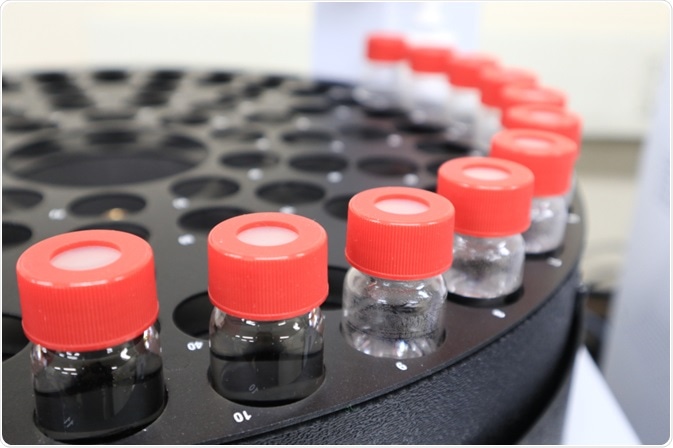side effects of cymbalta withdrawal
In chromatography, the components of a mixture are separated. This is made possible because different components interact with the mobile and solid phases differently, thus either being retained on the column (if it binds strongly to the solid phase) or not interacting with the column at all.
 Image Credit: hotsum / Shutterstock
Image Credit: hotsum / Shutterstock
These factors can be changed so that the process can be more efficient in terms of how long the run takes and how much reagents are required for the chromatography run. However, care needs to be taken to ensure good resolution.
Column efficiency
In order to determine the efficiency of the column, and thus the ability of the chromatography to get good resolution, there are two factors that are important to consider: peak maximum and peak widths.
Peak maximum is where the concentration of the compound is the highest, resulting in the largest peak. Where the peak maximum falls for two different compounds depends on how they interact with the column, as well as how they interact with the mobile phase.
Peak width, norvasc medicine or how wide the peaks are, is of a greater concern in chromatography. Even if the maxima of two peaks are well resolved, if these peaks become wider, then this might affect the resolution of the two peaks.
In order to determine how efficient a chromatography column is, the following equation can be applied:
N = 16 (tr/w)2
Here, N is the number of theoretical plates in the column, where tr is the retention time, or how long the compound is retained in the column after the mixture is injected, and w is the peak width. The peak width is measured by drawing a tangent line and measuring the distance between the points where the tangent line crosses the peak.
Quality of chromatography
The results from a chromatogram usually display peaks, and the resolution is how much two peaks are able to be distinguished from each other. Resolution is an important factor to consider when designing an experiment involving chromatography, and as an equation, resolution can be displayed as
R = (tr2 – tr1)
½(w1 + w2)
where t = retention times, and w = widths of the peak.
In relation to column efficiency, the value of N relates to the quality of the chromatogram. For example, if the peaks occur early (i.e. the tr value in the efficiency equation is low), and are broad (i.e. the value of w is high), then the N value will be low. The opposite is also true. A good chromatogram would have a high N value based on high tr and low w values in the efficiency equation.
How to improve chromatography efficiency
Purifying monoclonal antibodies
Monoclonal antibodies have multiple uses, such as diagnostics, therapeutics, protein purification and other molecular techniques. These can be produced by cell culture, or in vitro, and they need to be purified from the cell culture fluid.
Protein A is a protein made by a bacterium, Staphylococcus aureus, which binds to antibodies. This protein therefore can be used to separate antibodies from a mixed sample, like cell culture fluid.
During the manufacture of monoclonal antibodies, cell culture fluid is loaded onto a chromatography column with protein A and the fluid is passed through multiple times. These columns are not cheap, and account for the majority of the cost of monoclonal antibody production.
Cell culture purification
Mahajan et al. developed a continuous method where the cell culture fluid eluted from one column was passed through into a second, and then into a third column. Using three columns increased the binding capacity of the chromatography, resulting in a more efficient run.
This then resulted in a reduction in the time taken to run the chromatography, due to the fact that each column was either being loaded with the cell culture fluid or washed.
Using this process showed no decrease in the quality of the resulting purified antibodies compared to processes that are used currently. Thus, this process of using three columns simultaneously is a more efficient way to purify antibodies from cell culture fluid.
Sources
- https://www.britannica.com/science/chromatography
- www.britannica.com/science/chromatography/Efficiency-and-resolution
- www.sciencedirect.com/science/article/pii/S0021967312000684?via%3Dihub
- www.biologydiscussion.com/…/10045
- https://www.sciencedirect.com/topics/medicine-and-dentistry/protein-a
Further Reading
- All Chromatography Content
- Chromatography Overview
- Gas Chromatography-Mass Spectrometry (GC-MS) Applications
- High Performance Liquid Chromatography (HPLC)
- Liquid Chromatography-Mass Spectrometry (LC-MS) Applications
Last Updated: Oct 25, 2018

Written by
Dr. Maho Yokoyama
Dr. Maho Yokoyama is a researcher and science writer. She was awarded her Ph.D. from the University of Bath, UK, following a thesis in the field of Microbiology, where she applied functional genomics toStaphylococcus aureus . During her doctoral studies, Maho collaborated with other academics on several papers and even published some of her own work in peer-reviewed scientific journals. She also presented her work at academic conferences around the world.
Source: Read Full Article
